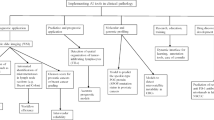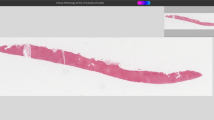Abstract
Pathology diagnosis relies mainly on the pathologists performing the examination on specimen glasses through microscopic. The process is time-consuming and highly experience-dependent. Recent advance in scanning speed, scanning resolution, and image quality shunts the lights on digitizing pathology images. Many promising and successful stories of artificial intelligence (AI) in diagnosing assistance further boost the acceptance of digital pathology. It is anticipated that with pathology slides digitized, tremendous benefits from AI assistive analysis can be brought in. While the lights have been shone, several issues also arise with the processing of digitized pathology images. The digitized pathology image has an image size of gigabytes. The targets for analysis could be very small and distributed all over the whole slide of images or mixed with various nontarget tissues. Some targets could appear of very large or very small sizes. These pose challenges on the labelling and processing of the whole slide pathology images. This chapter presents the issues and methods which have been developed to address the issues, when AI has been brought in as the assisted tools for digital pathology. Several examples on liver pathology image analysis are also presented.
Access this chapter
Tax calculation will be finalised at checkout
Purchases are for personal use only
Similar content being viewed by others
Abbreviations
- WSI:
-
whole slide image
- CAD:
-
computer-aided detection and/or diagnosis
- AI:
-
artificial intelligence
- CT:
-
computed tomography
- DCNN:
-
deep convolutional neural network
- CE:
-
Communate Europpene
- FAD:
-
US food and drug administration
- CNN:
-
convolutional neural network
- H&E:
-
haematoxylin and eosin
- IHC:
-
immunohistochemistry
- TLI:
-
tumor lymphocytic infiltration
- SPM:
-
spatial pyramid matching framework
- SVM:
-
support vector machine
- DCAN:
-
deep contour-aware network
- ASPP:
-
atrous spatial pyramid pooling
- MSCN:
-
multiscale convolutional network
- FA-MSCN:
-
Feature-Aligned Multiscale Convolutional Network
- SSCN:
-
single scale convolutional network
- IoU:
-
intersection over Union
- CAM:
-
class activation mapping
- AIH:
-
autoimmune hepatitis
- kNN:
-
k-nearest neighbors
- SMOTE:
-
synthetic minority oversampling technique
- ConvNet:
-
convolutional network
- AL:
-
active learning
- HoG:
-
Histogram of Oriented Gradients
- SIFT:
-
scale-invariant feature transform
- FCN:
-
fully convolution network
- MC:
-
Monte Carlo
- R-CNN:
-
Region-based CNN
- IEAL:
-
imbalance effective active learning
- DL:
-
dice loss
- DICOM:
-
Digital Imaging and Communications in Medicine
- IHE:
-
Integrating the Healthcare Enterprise
- ICC:
-
International Color Consortium
References
H. Cao, S. Bernard, L. Heutte, R. Sabourin, Improve the performance of transfer learning without fine-tuning using dissimilarity-based multi-view learning for breast cancer histology images, in International Conference Image Analysis and Recognition, (2018), pp. 779–787
C.H. Chan, T.T. Huang, C.Y. Chen, C.C. Lee, M.Y. Chan, P.C. Chung, Texture-map based branch-collaborative network for oral cancer detection. IEEE Trans. Biomed. Circ. Syst. 13(4), 766–780 (2019)
N.V. Chawla, K.W. Bowyer, L.O. Hall, W.P. Kegelmeyer, SMOTE: synthetic minority over-sampling technique. J. Artif. Intell. Res. 16, 321–357 (2002)
E.L. Chen, P.C. Chung, C.L. Chen, H.M. Tsai, C.I. Chang, An automatic diagnostic system for CT liver image classification. I.E.E.E. Trans. Biomed. Eng. 45(6), 783–794 (1998)
L.C. Chen, G. Papandreou, I. Kokkinos, K. Murphy, A.L. Yuille, DeepLab: semantic image segmentation with deep convolutional nets, Atrous convolution, and fully connected CRF. IEEE Trans. Pattern Anal. Mach. Intell. 4(4), 834–848 (2016)
H. Chen, X. Qi, L. Yu, Q. Dou, J. Qin, P.A. Heng, DCAN: deep contour-aware networks for object instance segmentation from histology images. Med. Image Anal., 496–504 (2017)
A. Cruz-Roa, H. Gilmore, A. Basavanhally, M. Feldman, S. Ganesan, N.N. Shih, A. Madabhushi, Accurate and reproducible invasive breast cancer detection in whole-slide images: a deep learning approach for quantifying tumor extent. Sci. Rep. 7(46450) (2017). https://doi.org/10.1038/srep46450
S. Ertekin, J. Huang, L. Bottou, L. Giles, Learning on the border: active learning in imbalanced data classification, in Proceedings of the Sixteenth ACM Conference on Conference on Information and Knowledge Management, (2007), pp. 127–136
W.H. Fridman, F. Pages, C. Sautes-Fridman, J. Galon, The immune contexture in human tumours: impact on clinical outcome. Nat. Rev. Cancer 12(4), 298–306 (2012)
C. Fu, W. Qu, Y. Yang, Actively learning from mistakes in class imbalance problems. IFAC Proc. Vol. 46(13), 341–346 (2013)
M. Gorriz, X. Giro-i-Nieto, A. Carlier, E. Faure, Cost-effective active learning for melanoma segmentation, in ML4H: Machine Learning for Health Workshop at NIPS, (2017)
K. He, R. Girshick, P. Dollár, Rethinking Imagenet Pre-training. arXiv preprint arXiv:1811.08883
W.C. Huang, P.C. Chung, H.W. Tsai, N.H. Chow, Y.Z. Juang, C.H. Wang, Automatic HCC detection using convolutional network with multi-magnification input images, in 2019 IEEE International Conference on Artificial Intelligence Circuits and Systems (AICAS), (2019), pp. 194–198
K. Ishak, A. Baptista, L. Bianchi, F. Callea, J. De Groote, F. Gudat, H. Denk, V. Desmet, G. Korb, R.N. MacSween, et al., Histological grading and staging of chronic hepatitis. J. Hepatol. 22(6), 696–699 (1995)
M. Kubat, S. Matwin, Addressing the curse of imbalanced training sets: one-sided selection, in Proceedings of the Fourteenth International Conference on Machine Learning (ICML), (1997), pp. 179–186
S.K. Lee, C.S. Lo, C.M. Wang, P.C. Chung, C.I. Chang, C.W. Yang, P.C. Hsu, A computer-aided design mammography screening system for detection and classification of microcalcifications. Int. J. Med. Inform. 60, 29–57 (2000)
S.K. Lee, P.C. Chung, C.I. Chang, C.-S. Lo, T. Lee, G.C. Hsu, C.W. Yang, Classification of clustered microcalcifications using a shape cognitron neural network. Neural Netw. 16, 121–132 (2003)
C.C. Lee, P.C. Chung, H.M. Tsai, Identifying multiple abdominal organs from CT image series using a multimodule contextual neural network and spatial fuzzy rules. IEEE Trans. Inf. Technol. Biomed. 7(8), 208–217 (2003)
C.T. Li, H.W. Tsai, T.L. Yang, K.S. Cheng, N.H. Chow, P.C. Chung, Imbalance-effective active learning in nucleus, lymphocyte and plasma cell detection, in Interpretable and Annotation-Efficient Learning for Medical Image Computing, MICCAI-LABEL 2020, Lecture Notes in Computer Science, vol. 12446, (2020), pp. 223–232
T.Y. Lin, P. Goyal, R. Girshick, K. He, P. Dollár, Focal loss for dense object detection, in Proceedings of the IEEE International Conference on Computer Vision, (2017), pp. 2980–2988
R. Mackowiak, P. Lenz, O. Ghori, F. Diego, O. Lange, C. Rother, Cereals-cost-effective Region-based Active Learning for Semantic Segmentation, arXiv preprint arXiv:1810.09726 (2018)
F. Milletari, N. Navab, S.A. Ahmadi, V-net: fully convolutional neural networks for volumetric medical image segmentation, in 2016 Fourth International Conference on 3D Vision (3DV), (2016), pp. 565–571
https://tpis.upmc.com/tpislibrary/schema/mHAI.html on Modified HAI Scoring System
F. Ozdemir, Z. Peng, C. Tanner, P. Fuernstahl, O. Goksel, Active learning for segmentation by optimizing content information for maximal entropy, in Deep Learning in Medical Image Analysis and Multimodal Learning for Clinical Decision Support, (2018), pp. 183–191
O. Ronneberger, P. Fischer, T. Brox, U-net: convolutional networks for biomedical image segmentation, in International Conference on Medical Image Computing and Computer-Assisted Intervention, (2015), pp. 234–241
A. Sadafi, N. Koehler, A. Makhro, A. Bogdanova, N. Navab, C. Marr, T. Peng, Multiclass deep active learning for detecting red blood cell subtypes in brightfield microscopy. Med. Image Comput. Comput. Assist. Intervent. (MICCAI), 685–693 (2019)
K. Sirinukunwattana, J.P. Pluim, H. Chen, X. Qi, P.A. Heng, Y.B. Guo, A. Böhm, Gland segmentation in colon histology images: the glas challenge contest. Med. Image Anal. 35, 489–502 (2017)
H. Tokunaga, Y. Teramoto, A. Yoshizawa, R. Bise, Adaptive weighting multi-field-of-view CNN for semantic segmentation in pathology, in Proceedings of the IEEE Conference on Computer Vision and Pattern Recognition, (2019), pp. 12597–12606
K. Wang, D. Zhang, Y. Li, R. Zhang, L. Lin, Cost-effective active learning for deep image classification. IEEE Trans. Circ. Syst. Video Technol. 27(12), 2591–2600 (2016)
Q.E. Xiao, P.C. Chung, H.W. Tsai, K.S. Cheng, N.H. Chow, Y.Z. Juang, H.H. Tsai, C.H. Wang, T.A. Hsieh, Hematoxylin and Eosin (H&E) stained liver portal area segmentation using multi-scale receptive field convolutional neural network. IEEE J. Emerg. Select. Top. Circ. Syst. 9(4), 623–634 (2019)
Y. Xu, Z. Jia, Y. Ai, F. Zhang, M. Lai, E.I.C. Chang, Deep convolutional activation features for large scale brain tumor histopathology image classification and segmentation, in ICASSP, IEEE International Conference on Acoustics, Speech and Signal Processing – Proceedings, (2015), pp. 947–951
Y. Xu, Y. Li, M. Liu, Y. Wang, M. Lai, E.I.C. Chang, Gland instance segmentation by deep multichannel side supervision, in Lecture Notes in Computer Science (Including Subseries Lecture Notes in Artificial Intelligence and Lecture Notes in Bioinformatics), (2016), pp. 496–504
L. Yang, Y. Zhang, J. Chen, S. Zhang, D.Z. Chen, Suggestive annotation: a deep active learning framework for biomedical image segmentation, in International Conference on Medical Image Computing and Computer-Assisted Intervention, (2017), pp. 399–407
W.J. Yang, Y.T. Cheng, P.C. Chung, Improved lane detection with multilevel features in branch convolutional neural networks. IEEE Access 7, 173148–173156 (2019)
Y. Zhou, H. Chang, K. Barner, P. Spellman, B. Parvin, Classification of histology sections via multispectral convolutional sparse coding, in Proceedings of the IEEE Computer Society Conference on Computer Vision and Pattern Recognition, (2014), pp. 3081–3088
B. Zhou, A. Khosla, A. Lapedriza, A. Oliva, A. Torralba, Learning deep features for discriminative localization, in 2016 IEEE Conference on Computer Vision and Pattern Recognition (CVPR), (2016), pp. 2921–2929
Z. Zhou, J. Shin, L. Zhang, S. Gurudu, M. Gotway, J. Liang, Fine-tuning convolutional neural networks for biomedical image analysis: actively and incrementally, in Proceedings of the IEEE Conference on Computer Vision and Pattern Recognition, (2017), pp. 7340–7351
R.X. Zhu, W.K. Seto, C.L. Lai, M.F. Yuen, Epidemiology of hepatocellular carcinoma in the Asia-Pacific region. Gut Liver 10(3), 332–339 (2016)
Acknowledgments
The authors would like to thank Drs. Hung-Wen Tsai and Nan-Haw Chow of National Cheng Kung University Hospital and Tsung-Lung Yang of Kaohsiung Veteran General Hospital for their data support and provision of domain knowledge. The authors would also like to thank Wei-Che Huang and Qi-En Xiao of National Cheng Kung University for making their experimental data available. The authors would like to thank National Center for High Performance Computing, Taiwan, for providing the computing power. Finally, the authors wish to acknowledge the financial support provided to this work by the Ministry of Science and Technology (MOST), Taiwan, under Grant No. MOST 108-2634-F-006 -004.
Author information
Authors and Affiliations
Corresponding author
Editor information
Editors and Affiliations
Rights and permissions
Copyright information
© 2022 Springer Nature Switzerland AG
About this chapter
Cite this chapter
Julia Chung, PC., Li, CT. (2022). When AI Meets Digital Pathology. In: Smith, A.E. (eds) Women in Computational Intelligence. Women in Engineering and Science. Springer, Cham. https://doi.org/10.1007/978-3-030-79092-9_6
Download citation
DOI: https://doi.org/10.1007/978-3-030-79092-9_6
Published:
Publisher Name: Springer, Cham
Print ISBN: 978-3-030-79091-2
Online ISBN: 978-3-030-79092-9
eBook Packages: Intelligent Technologies and RoboticsIntelligent Technologies and Robotics (R0)




